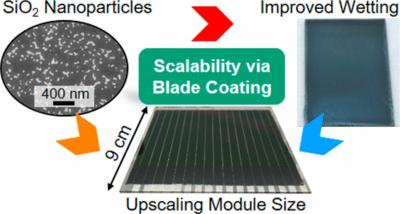Researchers from the Center for Solar Energy and Hydrogen Research Baden-Württemberg (ZSW) in Germany have transferred a practical wetting tool for solution-based perovskite processing to a scalable printing technique.

On the basis of their recent publication on the development of a universal nanoparticle (NP) wetting agent for perovskite precursor solutions on nonwetting materials via spin coating, the team showed for the first time its transfer to scalable gas stream-assisted blade coating of solution-processed perovskite solar cells (PSCs) and modules in the inverted device architecture with highly hydrophobic poly(triaryl amine) (PTAA) as hole transport layer (HTL) on large-area substrates.
In their work, detrimental techniques to enhance the PTAA surface energy, such as prewetting, plasma treatment, or surfactants are avoided.
Instead, they utilize blade coated nonconductive silicon oxide (SiO2) NPs between the hydrophobic PTAA and the perovskite layer. The NPs enhance the PTAA surface energy, thus, wetting and homogeneous spreading of the precursor solution on the HTL is strongly improved so that pinholes in the perovskite and thereby short-circuited devices are prevented.
Three major optimizations result in improved reproducibility and device performance of up to 17.9% power conversion efficiency (PCE) of blade coated PSCs with 0.24 cm2 active area: (i) adjusting the NP dispersion concentration, (ii) blending small amounts of lead chloride (PbCl2) in the perovskite precursor solution to improve perovskite layer formation by inhibiting void formation at the HTL interface, and (iii) adjusting the HTL thickness, which increased the fill factor (FF).
In addition, to prove the scalability of the blade-coated NP wetting agent concept, the team showed perovskite blade coating on enlarged substrates of up to 9 Ã 9 cm2. Furthermore, they reason that blade coating parameters, such as applied solution volume and coating speed, are highly crucial for the perovskite layer homogeneity in coating direction and device performance on large substrates.
Moreover, by implementing the blade coated NP wetting agent in the device stack modules reach maximum PCEs of 12.8%, 10.3%, and 9.3% on 3.80, 11.60, and 49.60 cm2 aperture area, respectively.

